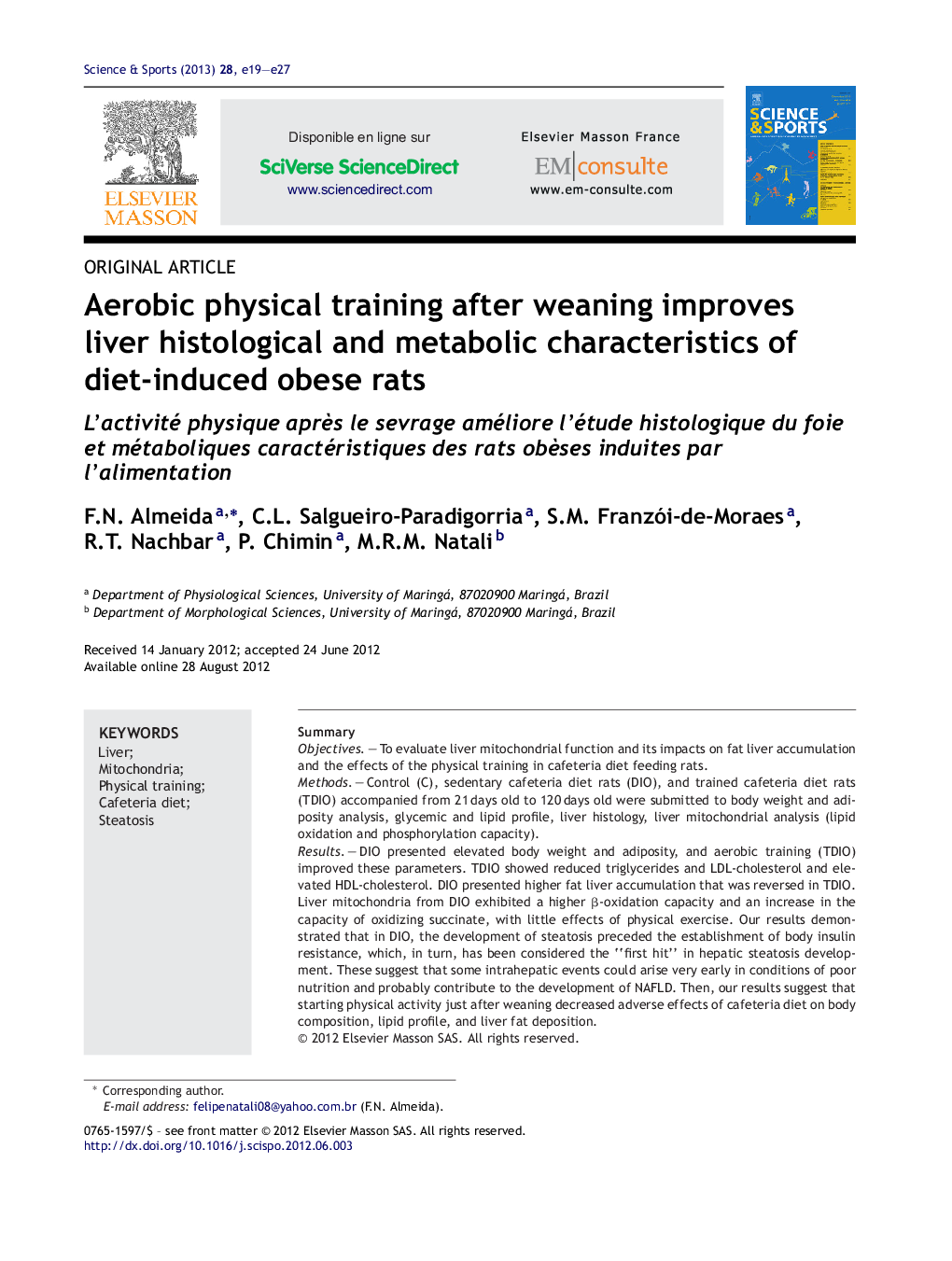| کد مقاله | کد نشریه | سال انتشار | مقاله انگلیسی | نسخه تمام متن |
|---|---|---|---|---|
| 4093069 | 1268286 | 2013 | 9 صفحه PDF | دانلود رایگان |

SummaryObjectivesTo evaluate liver mitochondrial function and its impacts on fat liver accumulation and the effects of the physical training in cafeteria diet feeding rats.MethodsControl (C), sedentary cafeteria diet rats (DIO), and trained cafeteria diet rats (TDIO) accompanied from 21 days old to 120 days old were submitted to body weight and adiposity analysis, glycemic and lipid profile, liver histology, liver mitochondrial analysis (lipid oxidation and phosphorylation capacity).ResultsDIO presented elevated body weight and adiposity, and aerobic training (TDIO) improved these parameters. TDIO showed reduced triglycerides and LDL-cholesterol and elevated HDL-cholesterol. DIO presented higher fat liver accumulation that was reversed in TDIO. Liver mitochondria from DIO exhibited a higher β-oxidation capacity and an increase in the capacity of oxidizing succinate, with little effects of physical exercise. Our results demonstrated that in DIO, the development of steatosis preceded the establishment of body insulin resistance, which, in turn, has been considered the “first hit” in hepatic steatosis development. These suggest that some intrahepatic events could arise very early in conditions of poor nutrition and probably contribute to the development of NAFLD. Then, our results suggest that starting physical activity just after weaning decreased adverse effects of cafeteria diet on body composition, lipid profile, and liver fat deposition.
RésuméObjectifsÉvaluer l’intérêt de l’activité physique chez des rats nourris au régime cafétéria sur la fonction mitochondriale hépatique et l’accumulation de graisse dans le foie.MéthodesDes rats témoins (C), sédentaires avec régime cafétéria (DIO), ou entraînés avec régime cafétéria (TDIO), ont été suivis du j21 au j120 après leur naissance. Le poids corporel et l’adiposité ont été mesurés, ainsi que les profils lipidique et glycémique. L’étude histologique du foie et la fonction de mitochondries hépatiques ont complété l’expérimentation (oxydation lipidique et capacité de phosphorylation).RésultatsLes rats DIO présentent un poids corporel et une adiposité élevés. L’activité physique (aérobie), chez les rats TDIO, améliore ces paramètres. Les rats TDIO montrent des taux réduits de triglycéride et de LDL-cholestérol et des taux élevés de HDL-cholestérol. Les rats DIO présentent une accumulation hépatique élevée de graisses, ce qui est corrigé par l’activité physique. Les mitochondries hépatiques provenant de rats DIO présentent une capacité de β-oxydation plus élevée et une augmentation de la capacité à oxyder le succinate (avec de faibles effets de l’activité physique). Nos résultats démontrent que chez les rats DIO, le développement d’une stéatose précède l’établissement de l’insulino-résistance qui, à son tour, est considérée comme précurseur du développement d’une stéatose hépatique. Cela suggère que certains évènements intrahépatiques pourraient survenir très tôt dans des conditions de nutrition pauvre et probablement contribuer au développement d’une stéatose hépatique non alcoolique (NAFLD). Nos résultats suggèrent que le fait de débuter l’activité physique juste après le sevrage améliore les effets négatifs du régime cafétéria sur la composition corporelle, le profil lipidique et la stéatose.
Journal: Science & Sports - Volume 28, Issue 2, April 2013, Pages e19–e27